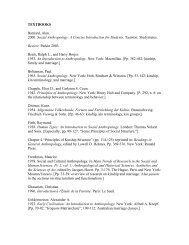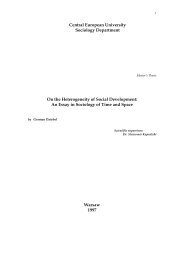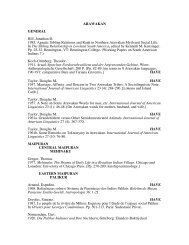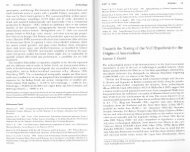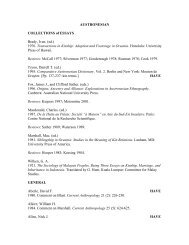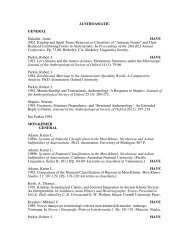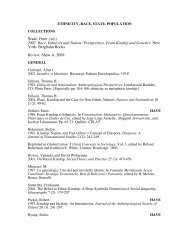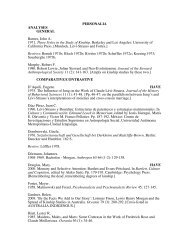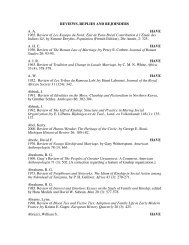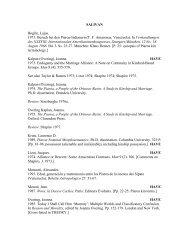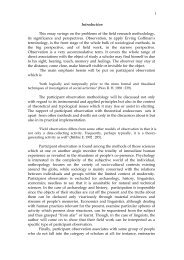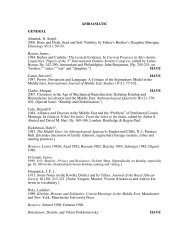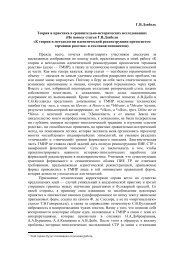5.56.Siouan - Kinship Studies
5.56.Siouan - Kinship Studies
5.56.Siouan - Kinship Studies
Create successful ePaper yourself
Turn your PDF publications into a flip-book with our unique Google optimized e-Paper software.
SIOUAN<br />
GENERAL<br />
DeMallie, Raymond J.<br />
2001. Procrustes and the Sioux: David M. Schneider and the Study of Sioux <strong>Kinship</strong>. In<br />
The Cultural Analysis of <strong>Kinship</strong>: The Legacy of David Schneider and Its Implications<br />
for Anthropological Relativism, edited by Richard Feinberg and Martin Ottenheimer. Pp.<br />
46-59. Urbana, IL: University of Illinois Press. [Cross-listed in THEORY.]<br />
Dorsey, J. Owen.<br />
HAVE<br />
1889. The Place of the Gentes in Siouan Camping Circles. American Anthropologist 2<br />
(4): 375-379.<br />
Hennepin, Lewis F.<br />
1699. A New Discovery of a Vast Country in America. Vols. 1-2. London: Red Lyon.<br />
[Vol. 2, 69: the Siouan custom of adoption and corresponding use of kin terms.]<br />
Kelty, Daniel.<br />
HAVE<br />
1999. Inalienable Possession in Siouan Languages. M.A. thesis. Lawrence: University of<br />
Kansas.<br />
Lesser, Alexander.<br />
HAVE<br />
1930. Some Aspects of Siouan <strong>Kinship</strong>. In Proceedings of the 23d International<br />
Congress of Americanists held at New York, September 17-22, 1928. Pp. 563-571. New<br />
York and Lancaster, PA: Science Press.<br />
Lesser, Alexander.<br />
1958. Siouan <strong>Kinship</strong>. Ph.D. dissertation: Columbia University. 331 P.<br />
HAVE<br />
Lowie, Robert H.<br />
HAVE<br />
1917. Notes on the Social Organization and Customs of the Mandan, Hidatsa, and Crow<br />
Indians. Anthropological Papers of the American Museum of Natural History 21 (pt. 1):<br />
1-99. [Entirely on kinship and marriage.]<br />
Marino, Mary C.<br />
1999. Siouans. In Encyclopedia of Canada’s Peoples, edited by Paul R. Magocsi. Pp. 93-<br />
98. Toronto: University of Toronto Press. [P. 95-96: “Family, <strong>Kinship</strong> and Social<br />
Organization.”]<br />
Matthews, G. H.<br />
HAVE<br />
1959. Proto-Siouan <strong>Kinship</strong> Terminology. American Anthropologist 61 (2): 252-278.\<br />
Speck, Frank G.<br />
HAVE<br />
1938. The Question of Matrilineal Descent in the Southeastern Siouan Area. American<br />
Anthropologist 40 (1): 1-12.<br />
COMPARATIVE<br />
Boas, Franz, and John R. Swanton.<br />
1911. Siouan (Dakota). In Handbook of American Indian Languages, edited by Franz<br />
Boas. (Smithsonian Institution, Bureau of American Ethnology Bulletin 40. Vol. 1.). Pp.<br />
875-966. Washington. [Pp. 946-948: kinship possession in Teton and Ponca].
SIOUAN PROPER<br />
CENTRAL<br />
MANDAN<br />
Bowers, Alfred W.<br />
1950. Mandan Social and Ceremonial Organization. Chicago, IL: University of Chicago<br />
Press. [Pp. 37-57: kinship system and terminology].<br />
Reviews: Colson 1951; Vidich 1951; Bruner 1952; Mandelbaum 1952.<br />
Bruner, Edward M.<br />
1955. Two Processes of Change in Mandan-Hidatsa <strong>Kinship</strong> Terminology. American<br />
Anthropologist 57: 840-850.<br />
Reprinted in: Readings in <strong>Kinship</strong> and Social Structure, edited by Nelson Graburn. Pp.<br />
119-126. New York: Harper & Row, 1971.<br />
Bruner, Edward M.<br />
1956a. Rejoinder. American Anthropologist 58 (3): 554-556. [Reply to Romney and<br />
Metzger. See THEORY.]<br />
Wood, W. Raymond.<br />
2001. Mandan. In Handbook of North American Indians. Vol. 13. Plains, edited by<br />
Raymond J. DeMallie. Pt. 1. Pp. 349-364. Washington: Smithsonian Institution. [Pp. 359:<br />
kinship.]<br />
MISSISSIPPI VALLEY<br />
CHIWERE<br />
IOWA<br />
Wedel, Milfred M.<br />
2001. Iowa. In Handbook of North American Indians. Vol. 13. Plains, edited by<br />
Raymond J. DeMallie. Pt. 1. Pp. 432-446. Washington: Smithsonian Institution. [P. 436-<br />
439: clans.]<br />
OTO<br />
Schweitzer, Marjorie M.<br />
2001. Otoe and Missouria. In Handbook of North American Indians. Vol. 13. Plains,<br />
edited by Raymond J. DeMallie. Pt. 1. Pp. 447-461. Washington: Smithsonian Institution.<br />
[P. 449: kinship.]<br />
Whitman, William.<br />
1937. The Oto. New York City: Columbia University Press. (Columbia University<br />
Contributions to Anthropology 28.) [Pp. 43-48: kin terminology.]<br />
HAVE<br />
DAKOTA<br />
ASSINIBOINE<br />
De Mallie, Raymond J., and David R. Miller.<br />
2001. Assiniboine. In Handbook of North American Indians. Vol. 13. Plains, edited by<br />
Raymond J. DeMallie. Pt. 1. Pp. 572-595. Washington: Smithsonian Institution. [P. 575:<br />
kinship.]
Lowie, Robert H.<br />
1909. The Assiniboine. Anthropological Papers of the American Museum of Natural<br />
History 4 (1). New York: American Museum of Natural History. [Pp. 36-38: kin<br />
terminology.]<br />
HAVE<br />
Cumberland, Linda A.<br />
2005. A Grammar of Assiniboine: A Siouan Language of the Northern Plains (Montana,<br />
Saskatchewan). Ph.D. dissertation. Indiana University. [Includes a chapter on kinship,<br />
with a comprehensive list of kin terms.]<br />
DAKOTA<br />
Anderson, Gary C.<br />
1984. Kinsmen of Another Kind: Dakota-White Relations in the Upper Mississippi<br />
Valley, 1650-1862. Lincoln: University of Nebraska Press.<br />
Reviews: Herring 1986; Wilson, R. 1989.<br />
DeMallie, Raymond J.<br />
1972. Teton Dakota <strong>Kinship</strong> and Social Organization. Ph.D. dissertation. University of<br />
Chicago.<br />
White, Joseph M., Joyzelle Godfrey, and Bill Iron Moccasin.<br />
2006. American Indian Fathering in the Dakota Nation: Use of Akicita as a Fatherhood<br />
Standard. Fathering 4 (1): 49-69.<br />
Landes, Ruth.<br />
1968. The Mystic Lake Sioux: Sociology of the Mdewakanton Santee. Madison, etc.:<br />
University of Wisconsin Press. [Pp. 95-104: kin terminology.]<br />
HAVE<br />
Reviews: Callender 1969; Corrigan 1969; Stipe 1971.<br />
Marino, Mary C.<br />
1979. Trends in Dakota <strong>Kinship</strong>. Na’pao 9: 37-40.<br />
O’Watch, Iris.<br />
1998. Wowahec un - <strong>Kinship</strong>. Saskatoon: Saskatchewan Indian Cultural Centre. 43 P.<br />
[Yankton kin terms, with a short introduction into the role of kinship in Nakota life.]<br />
Riggs, A. L.<br />
1881. Concerning Gentes and Phratries. American Antiquarian 4: 63-64.<br />
Riggs, Stephen R.<br />
1893. Dakota Grammar, Texts and Ethnography. Department of the Interior, U.S.<br />
Geographical and Geological Survey of the Rocky Mountain Region. Washington:<br />
Government Printing Office. (Contributions to North American Ethnology 9.) [Pp. XVII-<br />
XXIII: kin terminology; pp. 14-16, 44: inalienable possession; 45: some kin terms in a<br />
table.]<br />
HAVE<br />
Stipe, Claude E.<br />
HAVE<br />
1971. Eastern Dakota Clans: The Solution of a Problem. American Anthropologist 73 (5):<br />
1031-1035.
Wallis, Wilson D.<br />
1947. The Canadian Dakota. Anthropological Papers of the American Museum of<br />
Natural History 41 (pt. 1): 1-225. [Pp. 40-41: kin terminology.]<br />
Review: Carter 1948.<br />
Wallis, Wilson D., and Ruth S. Wallis.<br />
1953. The Sins of the Fathers: Concept of Disease among the Canadian Dakota.<br />
Southwestern Journal of Anthropology 9: 431-435.<br />
HAVE<br />
LAKOTA<br />
Albers, P. C.<br />
1982. Sioux <strong>Kinship</strong> in a Colonial Setting. Dialectical Anthropology 6 (3): 253-269.<br />
Biolsi, Thomas.<br />
1992. Organizing the Lakota: The Political Economy of the New Deal on the Pine Ridge<br />
and Rosebud Reservations. Tucson and London: University of Arizona Press. [P. 20: kin<br />
terms used with respect to American authorities.]<br />
DeMallie, Raymond J.<br />
HAVE<br />
1994. <strong>Kinship</strong> and Biology in Sioux Culture. In North American Indian Anthropology:<br />
Essays on Society and Culture, edited by Raymond J. DeMallie and Alfonso Ortiz. Pp.<br />
125-146. Norman and London: University of Oklahoma Press.<br />
Désveaux, Emmanuel.<br />
HAVE<br />
1997. Parenté, rituel, organisation sociale: Le cas des Sioux. Journal de la Société des<br />
Américanistes 83: 111-140.<br />
Hassrick, Royal B.<br />
1944. Teton Dakota <strong>Kinship</strong> System. American Anthropologist 46 (3): 338-347.<br />
HAVE<br />
Reuse, Willem J. de.<br />
1994. Noun Incorporation in Lakota (Siouan). International Journal of American<br />
Linguistics 60 (3): 199-260. [Pp. 228-231: inalienable possession, including kinship<br />
possession.]<br />
Trechter, Sara.<br />
1995. The Pragmatic Functions of Gender Deixis in Lakhota. Ph.D. dissertation.<br />
University of Kansas.<br />
HAVE<br />
Tyon, Thomas.<br />
HAVE<br />
1982. Oglala Kin Relationships. In Lakota Society by James R. Walker. Edited by<br />
Raymond J. DeMallie. Pp. 44-46. Lincoln and London: University of Nebraska Press.<br />
Walker, James R.<br />
1914. Oglala <strong>Kinship</strong> Terms. American Anthropologist 16 (1): 96-109.<br />
HAVE<br />
STONEY<br />
Getty, Ian A. L., and Erik D. Godding.
2001. Stoney. In Handbook of North American Indians. Vol. 13. Plains, edited by<br />
Raymond J. DeMallie. Pt. 1. Pp. 596-603. Washington: Smithsonian Institution. [P. 597:<br />
kinship.]<br />
DHEGIHA<br />
KANSA<br />
Bailey, Garrick A., and Gloria A. Young.<br />
2001. Kansa. In Handbook of North American Indians. Vol. 13. Plains, edited by<br />
Raymond J. DeMallie. Pt. 1. Pp. 462-475. Washington: Smithsonian Institution. [P. 470:<br />
“Unilineal descent groups.]<br />
OMAHA<br />
Barnes, R. H.<br />
1984. Two Crows Denies It: A History of Controversy in Omaha Sociology. Lincoln:<br />
University of Nebraska Press.<br />
Reviews: Duff-Cooper 1985; Scheffler 1986b; Schusky 1986; Bowden 1988.<br />
Dorsey, John O.<br />
HAVE<br />
1884. Omaha Sociology. In 3d Annual Report of the Bureau of Ethnology to the<br />
Secretary of the Smithsonian Institution, 1881-1882. Pp. 205-370. Washington:<br />
Government Printing Office. [Pp. 252-258: “The <strong>Kinship</strong> System and Marriage Laws.”]<br />
Ensor, Bradley E.<br />
HAVE<br />
2003b. <strong>Kinship</strong> and Marriage among the Omaha, 1886-1902. Ethnology 42 (1): 1-14.<br />
Fletcher, Alice C., and Francis La Flesche.<br />
1911. The Omaha Tribe. 27th Annual Report of the Bureau of American Ethnology to the<br />
Secretary of the Smithsonian Institution, 1905-1906. Pp. 17-672. Washington: Government<br />
Printing Office. [Pp. 313-318: kin terminology.]<br />
HAVE<br />
2d ed.: Lincoln: University of Nebraska Press, 1973.<br />
Review: Darnell 1973.<br />
Kronenfeld, David B.<br />
1989. Morgan vs. Dorsey on the Omaha Cross-Parallel Contrast: Theoretical Implications.<br />
L’Homme 29 (109): 76-106.<br />
Liberty, Margot P., W. Raymond Wood, and Lee Irwin.<br />
2001. Omaha. In Handbook of North American Indians. Vol. 13. Plains, edited by<br />
Raymond J. DeMallie. Pt. 1. Pp. 399-415. Washington: Smithsonian Institution. [P. 408:<br />
“<strong>Kinship</strong>.]<br />
Quimby, George I.<br />
HAVE<br />
1962-1963. Omaha <strong>Kinship</strong> Terminology and Spruce-Fir Pollen. American Antiquity 28:<br />
91-92. [“Omaha” in Winnebago as environmental adaptation.]<br />
Bailey, Garrick A.<br />
OSAGE
1970. Changes in Osage Social Organization: 1673-1969. Ph.D. dissertation. University<br />
of Oregon. 306 P.<br />
Bailey, Garrick A.<br />
2001. Osage. In Handbook of North American Indians. Vol. 13. Plains, edited by<br />
Raymond J. DeMallie. Pt. 1. Pp. 476-496. Washington: Smithsonian Institution. [P. 485:<br />
“<strong>Kinship</strong>.]<br />
Nett, Betty R.<br />
1951. Osage <strong>Kinship</strong>. M.A. thesis. University of Oklahoma. 90 P.<br />
Nett, Betty R.<br />
1952. Historical Changes in the Osage <strong>Kinship</strong> System. Southwestern Journal of<br />
Anthropology 8 (2): 164-181.<br />
HAVE<br />
Quintero, Carolyn.<br />
2004. Osage Grammar. Lincoln and London: University of Nebraska Press. [Pp. 481-<br />
487: kin terminology.] HAVE<br />
PONCA<br />
Brown, Donald N., and Lee Irwin.<br />
2001. Ponca. In Handbook of North American Indians. Vol. 13. Plains, edited by<br />
Raymond J. DeMallie. Pt. 1. Pp. 416-431. Washington: Smithsonian Institution. [P. 420:<br />
kinship.]<br />
Howard, James H.<br />
1965. The Ponca Tribe. Washington: Government Printing Office. (Bureau of American<br />
Ethnology, Bulletin 195.) [Pp. 81-84: kin terminology.]<br />
Review: Malouf 1966.<br />
QUAPAW<br />
Young, Gloria A., and Michael P. Hoffman.<br />
2001. Quapaw. In Handbook of North American Indians. Vol. 13. Plains, edited by<br />
Raymond J. DeMallie. Pt. 1. Pp. 497-514. Washington: Smithsonian Institution. [P. 500:<br />
kinship.]<br />
WINNEBAGO<br />
Helmbrecht, Johannes.<br />
HAVE<br />
2002. Nouns and Verbs in Hocank (Winnebago). International Journal of American<br />
Linguistics 68 (1): 1-27. [Pp. 22-23: kin terms as a special category of nouns.]<br />
Helmbrecht, Johannes.<br />
2003. Possession in Hocank (Winnebago): Problems for a Prototype Approach. Erfurt.<br />
(Arbeitspapiere des Seminars für Sprachwissenschaft der Universität Erfurt 8.)<br />
[Extensively on kinship possession.]<br />
Lurie, Nancy O.<br />
1978. Winnebago. In Handbook of North American Indians Vol. 15. Northeast, edited by<br />
Bruce G. Trigger. Pp. 690-707. Washington: Smithsonian Institution. [Pp. 694-695:<br />
kinship.]
Radin, Paul.<br />
1923. The Winnebago Tribe. In 37 th Annual Report of the Bureau of American Ethnology<br />
to the Secretary of the Smithsonian Institution, 1915-1916. Pp. 35-560. Washington:<br />
Government Printing Office. [Pp. 128-135: kin terminology, joking and avoidance<br />
relationships.]<br />
HAVE<br />
MISSOURI VALLEY<br />
GENERAL<br />
Bruner, Edward M.<br />
1956. Primary Group Experience and the Processes of Acculturation. American<br />
Anthropologist 58 (4): 605-623. [The influence of “acculturation” on Mandan, Hidatsa and<br />
Crow kinship systems.]<br />
Lowie, Robert H.<br />
1917. The <strong>Kinship</strong> Systems of the Crow and Hidatsa. In Proceedings of the 19th<br />
International Congress of Americanists, held at Washington, December 27-31, 1915,<br />
edited by F. W. Hodge. Pp. 340-343. Washington.<br />
Reprinted in: Lowie’s Selected Papers in Anthropology, edited by Cora Du Bois. Pp. 75-<br />
81. Berkeley and Los Angeles: University of California Press, 1960.<br />
ABSAROKA (CROW)<br />
Désveaux, Emmanuel.<br />
HAVE<br />
2002. Some Current <strong>Kinship</strong> Paradigms in the Light of True Crow Indian Ethnography.<br />
In Anthropology, By Comparison, edited by Andre Gingrich and Richard G. Fox. Pp.<br />
124-142. London and New York: Routledge.<br />
Frey, Rodney.<br />
1987. The World of the Crow Indians. Norman: University of Oklahoma Press. [Pp. 40-<br />
45: clans, kinship system and some kin terms.]<br />
Goldenweiser, Alexander A.<br />
HAVE<br />
1913. Remarks on the Social Organization of the Crow Indians. American Anthropologist<br />
15 (2): 281-294. [In connection with Lowie 1912.]<br />
Lowie, Robert H.<br />
1912. Social Life of the Crow Indians. Anthropological Papers of the American Museum<br />
of Natural History 9 (pt. 2): 179-248. [Pp. 207-212: kin terminology.]<br />
Lowie, Robert H.<br />
1931. Marriage and Society among the Crow Indians. In Source-Book in Anthropology,<br />
edited by A. L. Kroeber and T. T. Waterman. Pp. 304-309. New York: Harcourt, Brace<br />
and Company.<br />
Lowie, Robert H.<br />
1935. The Crow Indians. New York: Farrar&Rinehart. [Pp. 18-32: “<strong>Kinship</strong> and<br />
Affinity.”]<br />
Reviews: Michelson 1936; Phillips 1936.<br />
Real Bird, C. Lanny.
1997. “Ashaammaliaxxia,” the Apsaalooke Clan System: A Foundation for Learning.<br />
Ed.D. dissertation. Montana State University. 273 P.<br />
Roundface, Ingela.<br />
HAVE<br />
1999. <strong>Kinship</strong> as World View: A Means to Understand the Role of <strong>Kinship</strong> in Crow<br />
Indian Politics. Acta Americana 7 (1): 59-71. Uppsala.<br />
HIDATSA<br />
Barnes, Robert H.<br />
HAVE<br />
1980. Hidatsa Personal Names: An Interpretation. Plains Anthropologist 25 (90): 311-331.<br />
[Naming and kinship system.]<br />
Bowers, Alfred W.<br />
1965. Hidatsa Social and Ceremonial Organization. Washington: Government Printing<br />
Office. (Bureau of American Ethnology, Bull. 194.) [Pp. 64-125: clans, moieties and<br />
kinship system; 138-162: marriage and household.]<br />
Review: Bruner 1067.<br />
2d ed.: Lincoln: University of Nebraska Press, 1992.<br />
Review: Berman 1994.<br />
Mathews, Washington.<br />
1877. Ethnography and Philology of the Hidatsa Indians. Washington: Government<br />
Printing Office. [P. 555-557: kin terminology.]<br />
Stewart, Frank H.<br />
2001. Hidatsa. In Handbook of North American Indians. Vol. 13. Plains, edited by<br />
Raymond J. DeMallie. Pt. 1. Pp. 329-348. Washington: Smithsonian Institution. [Pp. 333-<br />
334: clans and phratries; 343-344: joking.]<br />
SOUTHEASTERN<br />
CATAWBA<br />
Speck, Frank G., and C. E. Schaeffer.<br />
HAVE<br />
1942. Catawba <strong>Kinship</strong> and Social Organization, with a resume of Tutelo kinship terms.<br />
American Anthropologist 44: 555-575.<br />
TUTELO<br />
Oliverio, Giulia R. M.<br />
HAVE<br />
1997. A Grammar and Dictionary of Tutelo. Ph. D. dissertation. Lawrence: University of<br />
Kansas.



